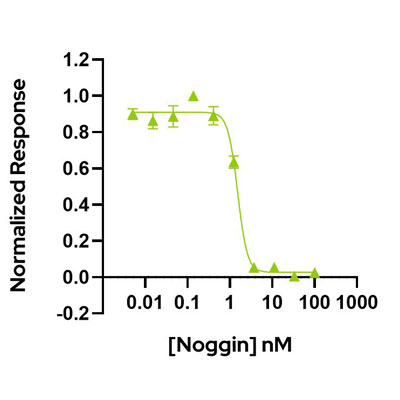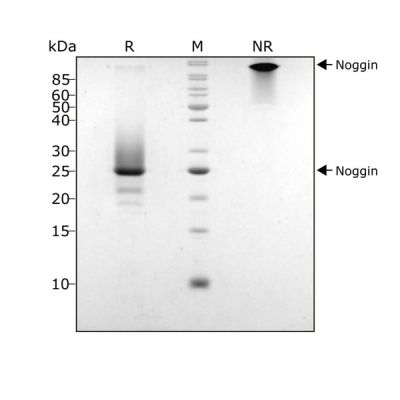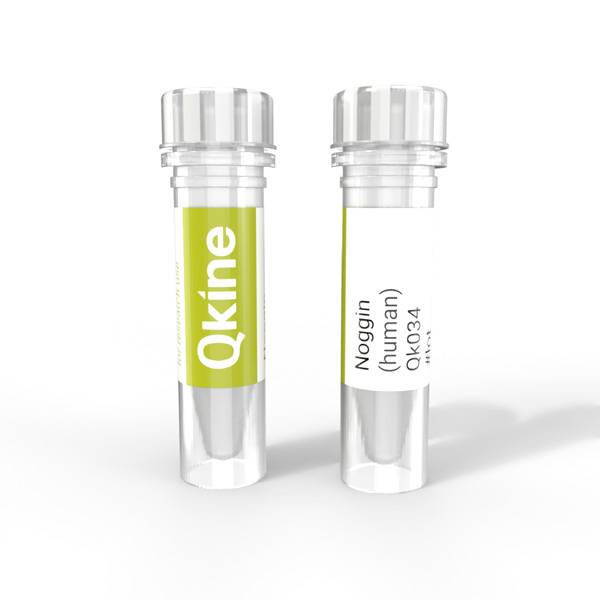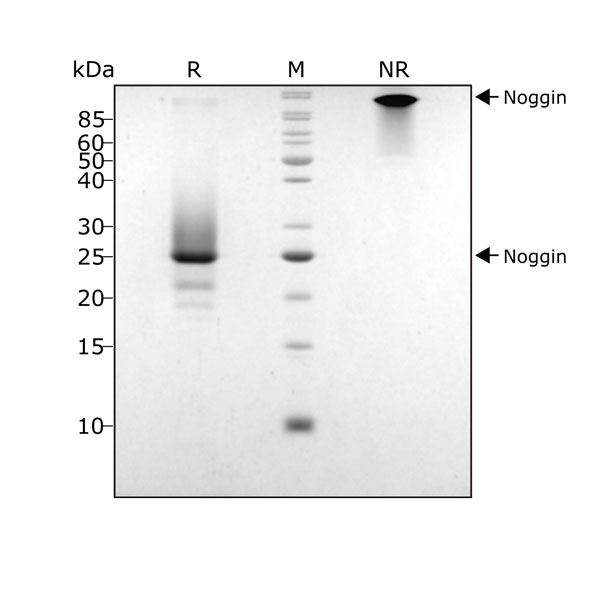Currency
Recombinant human noggin protein (Qk034)
Human noggin is a bone morphogenetic protein (BMP) antagonist which regulates cell differentiation and growth. Noggin is used in the culture of intestinal, pancreatic, lung and tumor-derived organoids and the maintenance of undifferentiated embryonic stem cells (ESC) and for stem cell differentiation into neural and microglial lineages.
Qkine human noggin (Qk034) is a highly pure, animal origin-free, bioactive 46 kDa dimer for reproducible results in organoid culture.
Orders are typically shipped same or next day (except Friday).
Easy world-wide ordering, direct or through our distributors.
1000µg will be despatched as 2 x 500µg
Fast and free shipping.
Buy online with secure credit card or purchase order.
For any questions, please email orders@qkine.com
Summary
High purity human Noggin protein (Uniprot: Q13253)
>98%, by SDS-PAGE quantitative densitometry
46 kDa (dimer)
Expressed in E. coli
Animal origin-free (AOF) and carrier protein-free.
Manufactured in our Cambridge, UK laboratories
Lyophilized from acetonitrile, TFA
Resuspend in 10mM HCl at >100 µg/ml (provided with protein and free of charge), prepare single use aliquots, add carrier protein if desired and store frozen at -20°C or -80°C
Featured applications
Tumor organoid culture
Epithelial organoid culture (WNR media)
Stem cell differentiation into neural and microglial lineages
Human
Species similarity:
mouse – 99%
rat – 99%
bovine – 99%
porcine – 99%
Bioactivity

Human Noggin is a BMP inhibitor, and its activity is determined by inhibition of BMP2 (Qk007) activity in a BMP-2 responsive firefly luciferase reporter assay. HEK293T cells are treated in triplicate with a serial dilution of Noggin and a standard concentration of BMP2 for 6 hours. Firefly luciferase activity is measured and normalized to the control Renilla luciferase activity. EC50 = 1.5 nM (70.1 ng/mL). Data from Qk034 lot #104291.
Purity

Noggin protein (Qk034) has an unusual migration in non-reduced (NR) SDS-PAGE due to the non-covalent dimer which is the active protein. Similar migration in SDS-PAGE is seen for Gremlin-1, a related BMP antagonist. The identity of the purified dimeric protein was confirmed using mass spectrometry. Upon reduction, the protein monomer migrates at 23 kDa. Purified recombinant human Noggin protein (7 μg) was resolved using 15% w/v SDS-PAGE in reduced (+β-mercaptoethanol, R) and non-reduced conditions (NR) and stained with Coomassie Brilliant Blue R250. Data from Qk034 lot #104285.
Further quality assays
Mass spectrometry: single species with expected mass
Analytical reversed-phase: single sharp peak
Endotoxin: <0.005 EU/μg protein (below level of detection)
Recovery from stock vial: >95%
We are a company founded and run by scientists to provide a service and support innovation in stem cell biology and regenerative medicine. All our products are exceptionally high purity, with complete characterisation and bioactivity analysis on every lot.
Protein background
Noggin is a 64 kDa homodimeric glycoprotein expressed during embryonic development and in adult cells [1]. Noggin is an extracellular antagonist of BMP cell signaling. BMPs are part of the larger TGFβ family and regulate embryonic, fetal and adult development in all vertebrates [1, 2]. Noggin binds to BMP-2, -4, -6 and -7, preventing interaction of the ligands with their receptor, and consequently blocking downstream activation of signaling cascades [2,3].
Through its control of BMP signaling, noggin plays a crucial role in embryonic patterning, as well as in the development of the neural tube, teeth, hair follicles, and the eye [4]. In cell cultures, noggin is used in the maintenance of pluripotent stem cells, differentiation of iPSCs to neural lineages, and in a large variety of organoid culture systems including intestine, liver and lung organoids [4, 5].
Additional resources
Publications
The effect of extracellular matrix on the precision medicine utility of pancreatic cancer patient–derived organoids
In JCI Insight on 5 December 2023 by Lumibao, J. C., Okhovat, S. et al.
Human epidermis organotypic cultures, a reproducible system recapitulating the epidermis in vitro
In Experimental Dermatology on 28 April 2023 by Agarwal, R. et al.
Spatial profiling of early primate gastrulation in utero
In Nature on 16 June 2022 by Bergmann, S., Penfold, C.A., Slatery, E. et al.
FAQ
Noggin is a bone morphogenic protein (BMP) inhibitor.
No, noggin is a BMP agonist.
Through binding to BMP and stopping BMP signaling, noggin controls the development of many embryonic structures.
Noggin binds to extracellular BMP, stopping is binding to its receptor.
Noggin can be added to embryonic and induced pluripotent stem cell cultures to preserve pluripotency.
Our products are for research use only and not for diagnostic or therapeutic use. Products are not for resale.
Share your thoughts!
Let us know what you think...
What others are saying




human Noggin worked very well for our organoids
PhD student at University of Basel –
I used several growth factors from Qkine including their new human Noggin and they worked very well for our organoids. I did not observe any differences when compared to the growth factors from other vendors. Their customer service is also excellent.
Upvote if this was helpful (0) Downvote if this was not helpful (0) Flag for removal
R. Agarwal, PhD student at University of Basel –
I used several growth factors from Qkine including their new human Noggin and they worked very well for our organoids. I did not observe any differences when compared to the growth factors from other vendors. Their customer service is also excellent.
Upvote if this was helpful (0) Downvote if this was not helpful (0) Flag for removal